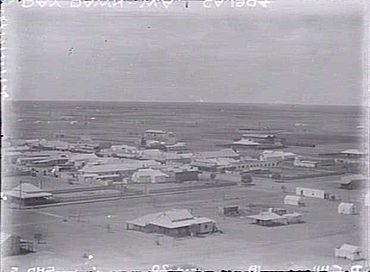Day Dawn, Western Australia facts for kids
Quick facts for kids Day DawnWestern Australia |
|
|---|---|

Day Dawn in 1904.
|
|
| Population | 0 (abandoned) |
| Established | 1894 |
| LGA(s) | Shire of Cue |
| State electorate(s) | North West |
| Federal Division(s) | Durack |
Day Dawn is a ghost town located in the Mid West region of Western Australia. It was once an important mining town, famous for its gold. You can find it a short distance south-west of Cue.
Contents
What is Day Dawn?
Day Dawn is known as a ghost town because it was abandoned. It used to be a busy place where people mined for gold. Today, most of its buildings are in ruins.
Early Days and Name Changes
In 1891, a man named Ned Heffernan found rich gold deposits here. This discovery led to the creation of the 'Day Dawn Reef'. At first, people informally called the settlement Four Mile. This was because it was about four miles from the town of Cue.
On March 2, 1894, it was officially named Bundawadra. But just a few months later, on May 25, 1894, its name was changed again to Day Dawn. The town even had its own local government, called the Municipality of Day Dawn, from 1894 to 1912. The Northern Railway arrived in nearby Cue in 1894, connecting the area to Mullewa.
Gold Mining in Day Dawn
Gold mining was the main activity in Day Dawn. Several mines and companies operated here. They used special machines called stamp mills to process the gold ore.
Important Mines and Companies
By 1895, several mines were active. These included the Day Dawn Associated Gold mine, Kinsella, Trenton, and the Day Dawn South mine. Each of these mines had ten-head stamp mills. These mills were used to crush the rock and extract the gold.
Miners' Protest
In 1899, miners in Day Dawn held a nine-week protest. They were unhappy about changes to their work conditions and pay. This showed how important the mining industry was to the town.
The Town's Decline
The Great Fingall Consolidated Gold Mining Company ran the main mine from 1898. However, the mine closed in 1918. By 1921, the old mine, known as the 'Great Fingall mine', had collapsed. By the 1930s, the town of Day Dawn had almost completely disappeared.
Today, nearly all the town's buildings are ruins. The only building still standing is the Great Fingall Mine office. This office is important and is listed on state and federal heritage registers.
Day Dawn Today
Since the early 1990s, different mining companies have worked in the area. They use modern methods like open-cut mining. They also reprocess old waste materials from past mining activities. Recently, Harmony Mining sold the mine to Monarch Gold. However, Monarch Gold faced financial difficulties.
Weather in Day Dawn
Day Dawn has a semi-arid climate. This means it has hot summers and mild to cool winters. Sometimes, the area can experience heavy rain and floods. For example, in 1925, several buildings in the town collapsed after heavy rain. The town received about 39.6 millimeters (1.56 inches) of rain in just two days.


